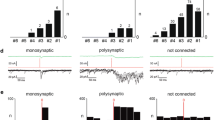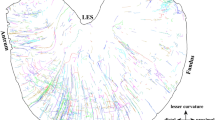Summary
Review of the anatomy of visceral afferent pathways. The peripheric nerve fibers of primary visceral afferents are both myelinated and unmyelinated. The myelinated fibers have caliber spectra encompassing categories from the largest to the smallest diameters.— The central connexions within the spinal cord of first order visceroafferent neurons are difficult to trace by anatomical means in consequence of the localization of both somatic and visceral primary sensory nerve cells in the spinal ganglia. An attempt is made to circumvent this difficulty by comparing degeneration patterns resulting from dorsal radicotomy in segments of comparable architecture having numerous (Th7–8) and relatively few (L3–4) visceral afferents. No useful difference could be observed in the substantia gelatinosa. Attention is called to the very massive degeneration encountered in the intermedio-medial nucleus in the level of Th7–8. Although the degeneration is still heavy in the same region in the level L3–4, however, it decreases sharply in the segments below. Considerable differences in degeneration patterns in Clarke's column after transection of dorsal roots subserving sensory innervation of the lower limb and of those from Th7–8 might suggest an entirely different — non proprioceptive (even perhaps visceroafferent) — function of the upper part of this nucleus. — In spite of its main involvement in cutaneous sensation the substantia gelatinosa from various reasons cannot be excluded from participation in visceral afferent transmission mechanisms. This problem is discussed briefly with respect to some new light- and electron microscopic information of its structures. — Ascending spinal and brainstem visceral pathways are discussed mainly in the light of recent information on the termination of antero-lateral tract fibers in brainstem regions other than the specific sensory nucleus of the thalamus. Several routes are suggested for visceral pain conduction, bypassing the nucleus ventralis postero-lateralis and reaching the frontoorbital cortex either directly over the dorsomedial thalamic nucleus or conveyed through the hypothalamus and the dorsomedial nucleus. — The role of the hypothalamus in transmission or integration of visceral afferent informations appears of having been underestimated. Evidence of mainly crossed ascending connexions between visceral receptors and the hypothalamus is discussed.
Zusammenfassung
Die peripherischen viscero-afferenten Nervenfasern sind sowohl markhaltig als auch marklos und erstere gehören zu sämtlichen Kalibergruppen von den größten bis zu den feinsten. — Wegen der Lokalisation sowohl somatischer als auch visceraler sensibler Neurone erster Ordnung in demselben Spinalganglion, ist es schwierig den mutmaßlich verschiedenen Verlauf ihrer zentralen Verbindungen im Rückenmark mit anatomischen Mitteln zu verfolgen. Es wird versucht diese Schwierigkeit zu umgehen, indem die Degenerationsmuster nach Hinterwurzeldurchschneidung in Segmenten vergleichbarer Architektur verglichen werden, die bekanntermaßen zahlreiche (Th7–8) und relativ wenig (L3–4) visceral afferente Neurone führen. Im Dorsalhorn sind keine verwertbaren Unterschiede zu beobachten. Die massive Degeneration im Nucleus intermedio-medialis ist in den Segmenten Th7–8 bemerkenswert. Sie ist allerding auch noch in Höhe L3–4 ausgesprochen, vermindert sich jedoch von hier abwärts zusehends. — Grundlegende Unterschiede im Verhalten der Verbindungen von Hinterwurzelkolateralen zur Clarkeschen Säule zwischen Wurzeln aus den hinteren Gliedmaßen und jenen der thoracalen Segmente, legen den Gedanken nahe, daß der obere Teil dieses Kernes eine besondere, nicht propriozeptive, ja vielleicht viscero-afferente Funktion hat. — Trotz unzweifelhaften Beziehungen der Substantia gelatinosa zur Hautsensibilität, ist ihre Rolle bei visceraler Sensibilität keineswegs abzustreiten. Diese Frage wird kurz an Hand neuer licht- und elektronenmikroskopischer Kenntnisse über die Struktur der Substantia gelatinosa diskutiert. — Aufsteigende spinale und Hirnstamm-Bahnen werden vorwiegend im Lichte der neueren Erkenntnisse über die Endigung aufsteigender Vorderseitenstrangsbahnen in Hirnstammgebieten außerhalb des spezifischen sensiblen Thalamuskerns besprochen. Verschiedene anatomisch mögliche Leitungswege, besonders für visceralen Schmerz, die den Nucleus ventralis-postero-lateralis umgehen, werden erwähnt. Sie können fronto-orbitale Rindenbezirke zum Teil unmittelbar über die intra-laminären Kerne und den Nucleus dorso-medialis thalami, oder mittelbar auf dem Wege: Substantia grisea centralis mesencephali ↦ Hypothalamus → Nucleus dorso-medialis thalami erreichen. —Die Rolle des Hypothalamus bei der Verarbeitung visceraler Afferenzen scheint bisher nicht genügend gewürdigt worden zu sein. Beweise vorwiegend gekreuzter, zugleich jedoch ziemlich unmittelbarer Verbindungen zwischen visceralen Rezeptoren und dem Hypothalamus werden besprochen.
Résumé
Aperçu sur l'anatomie des systèmes viscéro-afférents. Les fibres nerveuses périphériques viscéro-afférentes sont myélinisées ou non myélinisées et les premières appartiennent à tous les groupes de calibre, des plus grands jusqu'aux plus fins. —Etant donné que les cellules nerveuses tant des neurones somatiques que viscéraux sensibles de premier ordre sont localisées dans le même ganglion spinal, il est difficile de suivre le cours probablement différent de leurs connections centrales dans la moelle épinière par des moyens anatomiques. On tâche donc d'éluder cette difficulté en comparant les «patterns» de dégénérescence après radicotomie dorsale dans des segments d'une architecture comparable ayant de nombreux neurones viscéraux afférents (Th7–8) et en ayant relativement peu (L3–4). La substance gélatineuse ne révèle aucune différence appréciable. La dégénérescence massive du noyau intermédio-médial est nette dans les segments Th7–8. Bien que cette dégénérescence soit encore distincte au niveau L3–4, elle diminue nettement dans les segments inférieurs. Les différences fondamentales du dessin dégénératif dans la colonne de Clarke, après section des racines dorsales servant à l'innervation sensoriale du membre inférieur et de deux des segments thoraciques, suggèrent l'idée que la partie supérieure de ce noyau possède une fonction spéciale, non proprioceptive, peut-être même viscéro-afférente. — Malgré les rapports incontestables entre la substance gélatineuse et la sensibilité cutanée, sa participation dans le mécanisme transmissif des afférences viscérales ne peut pas être exclue pour différentes raisons. Le problème est brièvement discuté, compte tenu de notions récentes sur la structure de la substance gélatineuse révélées par les examens microscopiques lumineux et électroniques. — Les voies ascendantes de la moelle et du tronc cérébral sont décrites à la lumière d'informations récentes sur les terminaisons des voies de faisceaux antéro-latéraux dans des régions du tronc cérébral autres que le noyau sensoriel spécifique du thalamus. Différentes routes — anatomiquement possibles —contournant le noyau ventral postéro-latéral sont suggérées, surtout pour la conduction des douleurs viscérales. C'est en partie par les noyaux intralaminaires et le noyau dorso-médial du thalamus que ces routes peuvent atteindre les régions corticales fronto-orbitales, directement ou indirectement par la voie suivante: substance centrale grise du mésencéphale hypothalamus — noyau dorso-médial du thalamus. Le rôle de l'hypothalamus dans la transmission ou l'intégration des informations viscérales afférentes semble avoir été sous-estimé. Les preuves de connexions ascendantes le plus souvent croisées entre des récepteurs viscéraux et l'hypothalamus sont discutées.
Similar content being viewed by others
Literature
Amassian, V. E., Cortical representation of visceral afferents. J. Neurophysiol., Springfield,14 (1951), 433–449.
Cajal, Santiago Ramon y, Histologie du Système Nerveux de l'Homme et des Vertébrés. Tome I, A. Maloine Editeur, Paris, 1909.
Cannon, W. B., andA. Rosenblueth, Autonomic neuroeffector systems. McMillan & Co., New York, 1937.
Foerster, O., Über die Leitungsbahnen des Schmerzgefühls und die chirurgische Behandlung der Schmerzzustände. Urban & Schwarzenberg, Berlin, 1927.
Foerster, O., Symptomatologie der Erkrankungen des Rükkenmarkes und seiner Wurzeln. Bumke und Foersters Hdb. der Neurologie5 (1936), 1–403.
Freeman, W., andJ. W. Watts, Pain mechanisms and the frontal lobes: A study of prefrontal lobotomy for intractable pain. Ann. Int. Med.28 (1948), 747–754.
Halász, B., andJ. Szentágothai, Histologischer Beweis einer nervösen Signalübermittlung von der Nebennierenrinde zum Hypothalamus. Zschr. Zellforsch.50 (1959), 297–306.
Hubbard, J. I., andO. Oscarsson, Localization of the cell bodies of the ventral spinocerebellar tract in lumbar segments of the cat. J. Comp. Neurol., Philadelphia,118 (1962), 199–204.
Kiss, F., andE. Zádory, Experimentell-morphologische Analyse der Rami communicantes. Anat. Anz., Jena,91 (1941), 209–225.
Kiss, T., Experimentell-morphologische Analyse der Nebeniereninnervation. Acta anat., Basel,13 (1951), 81–89.
Kohnstamm, O., andF. Quensel, Centrum receptorium der Formatio reticularis und gekreuzt aufsteigende Bahn. Dtsch. Zschr. Nervenhk.36 (1908), 182–188.
Lundberg, A., andO. Oscarsson, Functional organization of the dorsal spinocerebellar tract in the cat. VII, Acta physiol. Scand.50 (1960), 356–379.
Lundberg, A., andO. Oscarsson, Functional organization of the ventral spinocerebellar tract in the cat. IV. Identification of units by antidromic activation from the cerebellar cortex. Acta physiol. Scand.54 (1962), 252–269.
Magoun, H. W., D. Atlas, E. H. Ingersoll andS. W. Ranson, Associated facial, vocal and respiratory components of emotional expression: an experimental study. J. Neurol.17 (1937), 241–255.
Mehler, W. R., M. E. Fefferman, andW. J. H. Nauta, Ascending axon degeneration following anterolateral chordotomy. An experimental study in the monkey. Brain, London,83 (1960), 718–750.
Melzack, R., W. Stotler, andW. K. Livingston, Effects of discrete brainstem lesions in cats on perception of noxious stimulation. J. Neurophysiol., Springfield,21 (1958), 353–367.
Moore, W. W., andA. V. Nalbandov, Neurogenetic effects of uterine distension on the oestrus cycle of the ewe. Endocrinology53 (1953), 1–11.
Milochin, A. A., Interoceptors of the alimentary tract in some lower vertebrates. (Russian.) Publishing House of the Soviet Academy of Science. Moscow-Leningrad, 1963.
Patton, H. D., andV. E. Amassian, Thalamic relay of splanchnic afferent fibres. Amer. J. Physiol.167 (1951), 815–816.
Perl, E. R., andW. S. Beacham, Background and reflex discharge of sympathetic preganglionic neurons in the spinal cat. J. Physiol., London,172 (1964), 400–416.
Porter, R. W., E. B. Cavanaugh, B. V. Critchlow andC. H. Sawger, Localized changes in electrical activity of the hypothalamus in estrous cats following vaginal stimulation. Amer. J. Physiol.189 (1957), 145–151.
Oscarsson, O., Differential course and organization of uncrossed and crossed long ascending spinal tracts In: Physiology of Spinal Neurons. J. C. Eccles and J. P. Schadé Editors, Progress in Brain Research12 (1964), 164–178.
Radnót, M., Tierexperimenteller Nachweis der Wirkung der inneren Sekretion auf den intraokularen Druck. Klin. Mbl. Augenhk., Stuttgart,110 (1944), 595–599.
Ranson, S. W., andP. R. Billingsley, The thoracic truncus sympathicus, rami communicantes and splanchnic nerves in the cat. J. Comp. Neurol., Philadelphia,29 (1918), 405–440.
Rexed, B., A cytoarchitectonic atlas of the spinal cord in the cat. J. Comp. Neurol., Philadelphia,100 (1954), 297–379.
Sawyer, C. E., andI. E. Markee, Estrogen facilitation of release of pituitary ovulatory hormone in the rabbit in response to vaginal stimulation. Endocrinology65 (1959), 614–621.
Schimert(Szentágothai),J., Das Verhalten der Hinterwurzelkollateralen im Rückenmark. Zschr. Anat. Entw.gesch.109 (1939), 666–697.
Székely, Gy., andJ. Szentágothai, Experiments with “model nervous systems”. Acta Biol. Ac. Sci. Hung.12 (1962), 253–269.
Szentágothai, J., Anatomical considerations of monosynaptic reflex arcs. J. Neurophysiol., Springfield,11 (1948), 445–454.
Szentágothai, J., Short propriospinal neurons and intrinsic connections of the spinal grey matter. Acta Morph. Ac. Sci. Hung.1 (1951), 81–94.
Szentágothai, J., Somatotopic arrangement of synapses of primary sensory neurons in Clarke's column. Acta Morph. Ac. Sci. Hung.10 (1961), 307–311.
Szentágothai, J., B. Flerkó, B. Mess andB. Halász, Hypothalamic control of the anterior pituitary. Akadémiai Kiadó, Budapest, 1962.
Szentágothai, J., Neuronal and synaptic arrangement in the substantia gelatinosa Rolandi. J. Comp. Neurol., Philadelphia,122 (1964), 219–240.
Wall, P. D., The origin of a spinal cord slow potential. J. Physiol.164 (1962), 508–526.
Author information
Authors and Affiliations
Additional information
With 3 Figures
Rights and permissions
About this article
Cite this article
Szentágothai, J. Pathways and subcortical relay mechanisms of visceral afferents. Acta Neurovegetativa 28, 103–120 (1966). https://doi.org/10.1007/BF01227375
Issue Date:
DOI: https://doi.org/10.1007/BF01227375




